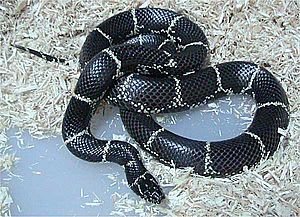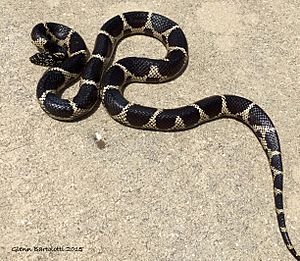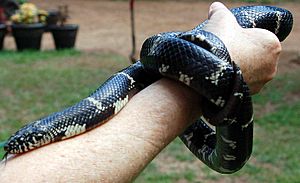Eastern kingsnake facts for kids
Quick facts for kids Eastern kingsnake |
|
|---|---|
 |
|
| Conservation status | |
| Scientific classification | |
| Genus: |
Lampropeltis
|
| Species: |
getula
|
| Synonyms | |
|
|
The eastern kingsnake (scientific name: Lampropeltis getula) is a type of snake found in the United States and Mexico. It's also known as the common kingsnake or chain kingsnake. These snakes are harmless to humans. They are very popular among snake collectors. There are currently nine different types, or subspecies, of the eastern kingsnake.
Contents
About the Eastern Kingsnake

Eastern kingsnakes can grow quite long. The smallest type, the speckled kingsnake, averages about 91.5 cm (36.0 in) long. The largest type, the eastern kingsnake itself, averages about 107 cm (42 in) long. Some very big kingsnakes have been found that are over 208.2 cm (82.0 in) from nose to tail tip! Their weight can range from about 285 g (10.1 oz) for a small one to over 2,268 g (80.0 oz) for a large one.
These snakes usually have a shiny black, blue-black, or dark brown body. They have a pattern of 23 to 52 white rings that look like a chain. Kingsnakes living near the coast often have wider bands. Those in mountains might have thinner bands or be completely black.
Other Names for This Snake
People call the eastern kingsnake by many names. Some common ones are:
- eastern kingsnake
- common kingsnake
- chain kingsnake
- kingsnake
- Carolina kingsnake
- chain snake
- black kingsnake
- rattlesnake pilot
In North Carolina, some people even call it the "pied piper."
Where They Live
Eastern kingsnakes live in many parts of the United States. You can find them in states like Florida, Georgia, Texas, and California. They also live in northern Mexico, including Baja California. Interestingly, some have also been found in the Canary Islands. In 2014, it was thought that about 20,000 kingsnakes lived there.
Their Home Environment
Kingsnakes like to live in open areas. This includes grassy fields, bushy areas, and forests with oak trees. They also like old farms, deserts, and low mountains. You can often find them near water, like swamps, canals, and streams.
What They Eat
Eastern kingsnakes are known for eating other snakes. This includes venomous snakes like copperheads! Copperheads cause many snakebites in the United States. Kingsnakes have a special way of hunting venomous snakes. They clamp down on the prey's jaws to avoid being bitten. Even if they do get bitten, they are immune to the venom!
Besides snakes, they also eat frogs, turtle eggs, lizards, and small mammals. They kill their prey by squeezing them tightly. This is called constriction.
How They Have Babies
Eastern kingsnakes lay eggs. This means they are oviparous. Adult female snakes can lay several dozen eggs at a time. The eggs hatch after about 2 to 2.5 months. When baby kingsnakes hatch, they are very colorful. They eat small snakes, lizards, and tiny rodents.
Kingsnakes as Pets
Eastern kingsnakes have been popular pets for a long time. They do very well when kept by people. They can live for 25 years or even longer! Some of the most popular types of kingsnakes kept as pets include the California, Brooks', Florida, and Mexican black kingsnakes.
Images for kids
See also
 In Spanish: Serpiente real común para niños
In Spanish: Serpiente real común para niños




